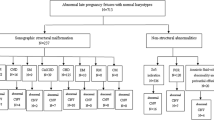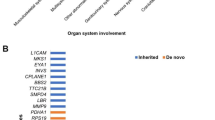Abstract
Purpose
To analyze copy number variants (CNVs) in subjects with small for gestational age (SGA) in China.
Methods
A total of 85 cases with estimated fetal weight (EFW) or birth weight below the 10th percentile for gestational age were recruited, including SGA associated with structural anomalies (Group A, n = 20) and isolated SGA (Group B, n = 65). In all cases, cytogenetic karyotyping and infection screening were normal. We examined DNA from fetuses (amniocentesis or cordocentesis) and newborns (cord blood) to detect CNVs using a single nucleotide polymorphism (SNP, n = 75) array or low-pass whole-genome sequencing (WGS, n = 10).
Results
Of 85 total cases, 3 (4%) carried pathogenic chromosomal abnormalities, including 2 cases with pathological CNVs and 1 case with upd(22)pat. In Group A, the mean gestational age at the time of diagnosis was 26.8 (SD 4.1) weeks and mean EFW/birth weight was 907.2 (SD 567.8) g. In Group B, the mean gestational age at the time of diagnosis was 34.1 (SD 5.8) weeks. Mean EFW/birth weight was 1879.2 (SD 714.5) g. The pathologic detection rate was 10% (2/20) in Group A and 2% (1/65) in Group B. It was inclined that the lower the EFW percentile, the more frequent the occurrence of CNVs.
Conclusions
Pathological subchromosomal anomalies were detected by CMA or low-pass WGS in 10% and 2% of SGA subjects with and without malformation, respectively. SGA fetuses with structural anomalies presented with higher pathological subchromosomal anomalies. The molecular genetic analysis is not recommended for isolated SGA pregnancies without other abnormal findings.

Similar content being viewed by others
References
Lee PA, Chernausek SD, Hokken-Koelega AC, Czernichow P (2003) International small for gestational age advisory board consensus development conference statement: management of short children born small for gestational age, April 24-October 1, 2001. Pediatrics 111:1253–1261
Eydoux P, Choiset A, Le Porrier N, Thepot F, Szpiro-Tapia S, Alliet J, Ramond S, Viel JF, Gautier E, Morichon N et al (1989) Chromosomal prenatal diagnosis: study of 936 cases of intrauterine abnormalities after ultrasound assessment. Prenat Diagn 9:255–269
Biron-Shental T, Sharony R, Shtorch-Asor A, Keiser M, Sadeh-Mestechkin D, Laish I, Amiel A (2016) Genomic alterations are enhanced in placentas from pregnancies with fetal growth restriction and preeclampsia: preliminary results. Mol Syndromol 6:276–280. https://doi.org/10.1159/000444064
Borrell A, Grande M, Pauta M, Rodriguez-Revenga L, Figueras F (2018) Chromosomal microarray analysis in fetuses with growth restriction and normal karyotype: a systematic review and meta-analysis. Fetal Diagn Ther 44:1–9. https://doi.org/10.1159/000479506
Borrell A, Grande M, Meler E, Sabria J, Mazarico E, Munoz A, Rodriguez-Revenga L, Badenas C, Figueras F (2017) Genomic microarray in fetuses with early growth restriction: a multicenter study. Fetal Diagn Ther 42:174–180. https://doi.org/10.1159/000452217
Reches A, Hiersch L, Simchoni S, Barel D, Greenberg R, Sira LB, Malinger G, Yaron Y (2018) Whole-exome sequencing in fetuses with central nervous system abnormalities. J Perinatol 38:1301–1308. https://doi.org/10.1038/s41372-018-0199-3
Nolan D, Carlson M (2016) Whole exome sequencing in pediatric neurology patients: clinical implications and estimated cost analysis. J Child Neurol 31:887–894. https://doi.org/10.1177/0883073815627880
Canton AP, Costa SS, Rodrigues TC, Bertola DR, Malaquias AC, Correa FA, Arnhold IJ, Rosenberg C, Jorge AA (2014) Genome-wide screening of copy number variants in children born small for gestational age reveals several candidate genes involved in growth pathways. Eur J Endocrinol 171:253–262. https://doi.org/10.1530/eje-14-0232
Hadlock FP, Harrist RB, Sharman RS, Deter RL, Park SK (1985) Estimation of fetal weight with the use of head, body, and femur measurements—a prospective study. Am J Obstet Gynecol 151:333–337
American College of Obstetricians and Gynecologists (2013) ACOG Practice bulletin no.134: fetal growth restriction. Obstet Gynecol 121:1122–1133. https://doi.org/10.1097/01.AOG.0000429658.85846.f9
Figueras F, Gratacos E (2014) Update on the diagnosis and classification of fetal growth restriction and proposal of a stage-based management protocol. Fetal Diagn Ther 36:86–98. https://doi.org/10.1159/000357592
Kearney HM, Thorland EC, Brown KK et al (2011) American College of Medical Genetics standards and guidelines for interpretation and reporting of postnatal constitutional copy number variants. Genet Med 13(7):680–685. https://doi.org/10.1097/GIM.0b013e3182217a3a
American College of Obstetricians and Gynecologists Committee on Genetics (2013) Committee opinion No. 581: the use of chromosomal microarray analysis in prenatal diagnosis. Obstet Gynecol 122:1374–1377. https://doi.org/10.1097/01.AOG.0000438962.16108.d1
Wapner RJ, Martin CL, Levy B, Ballif BC, Eng CM, Zachary JM (2012) Chromosomal microarray versus karyotyping for prenatal diagnosis. 367(23):2175–2184. https://doi.org/10.1056/NEJMoa1203382
Callaway JL, Shaffer LG, Chitty LS, Rosenfeld JA, Crolla JA (2013) The clinical utility of microarray technologies applied to prenatal cytogenetics in the presence of a normal conventional karyotype: a review of the literature. Prenat Diagn 33:1119–1123. https://doi.org/10.1002/pd.4209
Lu XY, Phung MT, Shaw CA et al (2008) Genomic imbalances in neonates with birth defects: high detection rates by using chromosomal microarray analysis. Pediatrics 122:1310–1318. https://doi.org/10.1542/peds.2008-0297
Brun S, Pennamen P, Mattuizzi A, Coatleven F, Vuillaume ML, Lacombe D, Arveiler B, Toutain J, Rooryck C (2018) Interest of chromosomal microarray analysis in the prenatal diagnosis of fetal intrauterine growth restriction. Prenat Diagn 38:1111–1119. https://doi.org/10.1002/pd.5372
Itsara A, Cooper GM, Baker C et al (2009) Population analysis of large copy number variants and hotspots of human genetic disease. Am J Hum Genet 84:148–161. https://doi.org/10.1016/j.ajhg.2008.12.014
Cooper GM, Coe BP, Girirajan S et al (2011) A copy number variation morbidity map of developmental delay. Nat Genet 43(9):838–846. https://doi.org/10.1038/ng.909
Redon R, Ishikawa S, Fitch KR et al (2006) Global variation in copy number in the human genome. Nature 444:444–454. https://doi.org/10.1038/nature05329
South ST, Lee C, Lamb AN, Higgins AW, Kearney HM (2013) ACMG standards and guidelines for constitutional cytogenomic microarray analysis, including postnatal and prenatal applications: revision 2013. Genet Med 15:901–909. https://doi.org/10.1038/gim.2013.129
Martin CL, Kirkpatrick BE, Ledbetter DH (2015) Copy number variants, aneuploidies, and human disease. Clin Perinatol 42:227–242. https://doi.org/10.1016/j.clp.2015.03.001
Eggermann T, Zerres K, Eggermann K, Moore G, Wollmann HA (2002) Uniparental disomy: clinical indications for testing in growth retardation. Eur J Pediatr 161:305–312. https://doi.org/10.1007/s00431-002-0916-x
Yu HE, Hawash K, Picker J, Stoler J, Urion D, Wu BL, Shen Y (2012) A recurrent 1.71 Mb genomic imbalance at 2q13 increases the risk of developmental delay and dysmorphism. Clin Genet 81:257–264. https://doi.org/10.1111/j.1399-0004.2011.01637.x
Funding
This study was supported by the National Key Research and Development Program of China (Grant No. 2016YFC1000104 and 2016YFC1000101), Beijing Municipal Administration of Hospitals’ Ascent Plan (Grant No. DFL20151302), and National Science and Technology Infrastructure Program (Grant No. 2014BAI06B05).
Author information
Authors and Affiliations
Contributions
Protocol/project development and study design: YM, CY and QW; drafting of the study and revision for important intellectual content: KOK, YJ, CY and LL; data collection: YM, YP and XL; data analysis and interpretation: YM and JW; manuscript writing/editing: YM; KOK; substantial contributions to the study conception: QW; final approval of the version to be published: YM and QW.
Corresponding author
Ethics declarations
Conflict of interest
The authors declare that they have no conflict of interest.
Ethical approval
This study was approved by the Ethics Committee of Beijing Obstetrics and Gynecology Hospital and was in accordance with the 1964 Helsinki Declaration and its later amendments.
Informed consent
Each participant in this study signed an informed consent form.
Additional information
Publisher's Note
Springer Nature remains neutral with regard to jurisdictional claims in published maps and institutional affiliations.
Rights and permissions
About this article
Cite this article
Ma, Y., Pei, Y., Yin, C. et al. Subchromosomal anomalies in small for gestational-age fetuses and newborns. Arch Gynecol Obstet 300, 633–639 (2019). https://doi.org/10.1007/s00404-019-05235-4
Received:
Accepted:
Published:
Issue Date:
DOI: https://doi.org/10.1007/s00404-019-05235-4




